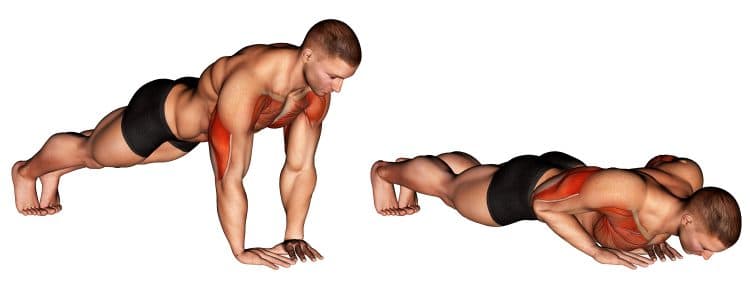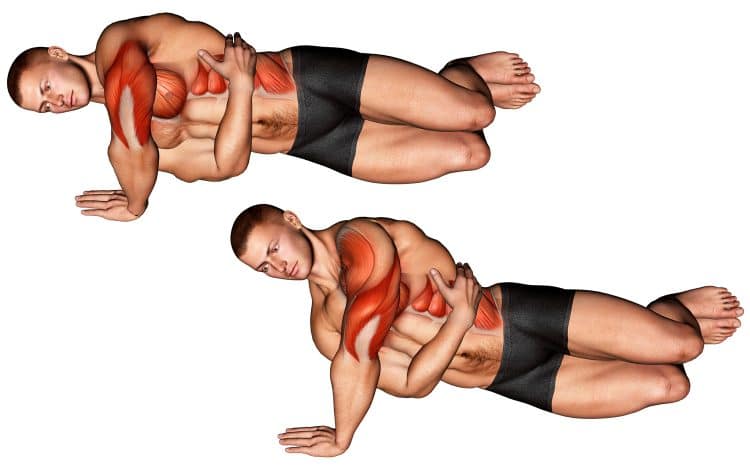At first glance, the side push-up appears as a beginner or rehabbing exercise. But it’s not recommended for either. In fact, you need to have a good level of upper body pushing strength to do it. It’s a great bodyweight triceps and chest movement that can be done anywhere to challenge your upper body and create new muscle tissue. Mix up your arm workouts with an off-kilter exercise and train them from a different angle than what you’re used to.
Check out our complete side push-ups training guide for form tips, a list of benefits, variations, sets and reps, and more.
[sc name=”style-blue-box” ]
In This Exercise:
- Target Muscle Group: Triceps, pectoralis major
- Type: Strength and hypertrophy
- Mechanics: Compound
- Equipment: Bodyweight
- Difficulty: Intermediate/advanced
[/sc]
How To Do Side Push-Ups
Form and movement execution are key to doing side push-ups effectively. On one hand, you want them to be challenging and effective but you can’t be too strict otherwise you’ll struggle to do a few reps.
- Lie on your side, one leg on top of the other with your bottom arm out in front of you and not tucked under your torso.
- Wrap your bottom arm around the front of your torso for balance. Place the palm of your top arm flat on the floor just outside of your bottom arm near your elbow with the fingers pointing up toward your head.
- Bend your knees and lift your legs a few inches off the ground.
- Push hard into the ground with your top arm and use your obliques and core muscles to lift your upper body into near full elbow extension. Squeeze your triceps at the top.
- Lower yourself back down slowly and stop when your upper arm is slightly higher than parallel to the floor. Try to find a middle range of motion and don’t go below it.
- Repeat for the desired number of reps and then switch sides.
Side Push-Up Benefits
Push-up variations are a classic bodyweight chest and triceps exercise but what gives them an advantage over other movements?
Lots of variations
You won’t find a type of exercise with more variations than push-ups and all involve the triceps and chest muscles. There are literally so many that we could list at least a hundred. Side push-ups are a good example of how you can change the positioning of your body to target the triceps brachii and there are several great options that will have the same effect.
Related: 15 Intense Push-Up Variations for Bodybuilders
Build a stronger, more muscular upper body
At some point basic push-ups become too easy if you do them enough. To extend from the previous mentioned benefit, you’ll need to try some advanced variations to continue challenging your muscles because hypertrophy is a result of progressive overload overtime, or pushing your muscles to lift more or perform more repetitions.
Side push-ups are not just a gym class exercise. If you do them with proper technique they should be very challenging, especially for heavier individuals.
Unilateral exercise
Unliteral means working one side at a time and when it comes to bodyweight exercises, using one arm is always harder than two. Of course, you’re only lifting a portion of your body weight when performing side push-ups like most push-up variations, but because the movement shifts the load onto the triceps rather than the chest and triceps, you’ll notice it’s not as easy as it looks.
A good example is going from a basic two arm push-up to a single-arm push-up. It instantly changes the movement from a beginner exercise to a more advanced one.
No weights or equipment needed
Your bodyweight is the only form of resistance which means you can lie down on any suitable surface and perform side push-ups.
Drawbacks
With such an effective exercise, there’s always a drawback or two.
A very challenging exercise
Some people might underestimate the side push-up because they can bust out 20 normal chest push-ups like nothing. But for this variation, the smaller triceps muscles (not chest) are the primary movers and if you do them with strict form they’re extremely challenging.
A little awkward
The word side push-up just sounds a little awkward (like who does a push-up on their side)? Well, it sort of is.
If you don’t have motion in your joints, then you may want to skip out on this exercise. Plus you’re turned to the side with your arm pressed against your body and trying to balance on one arm.
With that being said, we still really like this movement and after you get used to it there should be no issues.
Can place a lot of stress on the elbows
If you’re not careful, using too strict form can place a lot of stress on your elbow joints. Unlike weight training, you cannot adjust the resistance and this is dangerous because many strain to push themselves up and it’s fighting a lost battle.
Common Mistakes
Let’s talk about what not to do when performing side push-ups.
Being too strict – If you’re too strict with side push-up form you may not be able to do very many, if any at all. Trying to press your body up while lying on your side aint easy and if you don’t believe us try if for yourself! But that doesn’t mean to get sloppy. Still focus on using your triceps to push you up but allow your body to move with you.
Too little range of motion – You’ll see people barely bending their elbows when doing side push-ups. This goes against what we know is the best way to build strength and muscle mass. It will something but you’d be better off doing something else.
Too much range of motion – we don’t recommend using too large range of motion either as it can make the exercise impossibly difficult and you’ll strain your elbows. You don’t want to go all the way down during the negatives but rather, stay mid range.
Variations
It doesn’t get better than side push-ups for a bodyweight-only triceps building exercise. But whether you’re a beginner or more advanced, you may benefit more from these variations/alternatives.
1. Weighted/partner assisted
Because side push-ups are a little more awkward there aren’t many options to add more resistance. Of course, there are two that can work which should be sufficient anyway. You can wear a weighted vest or have a training partner apply more resistance by pressing their weight into yours.
2. Reverse dip
Not quite ready for side push-ups? try reverse dips, a two arm push-up variation that combines a conventional bodyweight chest press and a yoga pose. Like side push-ups, it shifts more emphasis onto the triceps muscles and they’re not an easy movement while being just as awkward but effective.
3. One arm dip
The one arm bench dip is a slightly easier exercise than side push-ups because while you shouldn’t cheat, your legs can assist during the movement if needed. Although if you’re a beginner, we do recommend that you get proficient at the two arm bench dip.
4. Triangle push-up

Triangle push-ups were rated the top triceps exercise in an Ace (American Council on Exercise) sponsored study when compared to triangle push-ups, kickbacks, dips, overhead extensions, rope and bar pushdowns, lying extensions and the close-grip bench press.
The explanation was that it’s harder to cheat and use momentum making triangle push-ups a more pure triceps-focused exercise.
Does that mean it’s better than the other exercises? Not necessarily as there are many factors involved in studies.
5. Single arm push-up
Single-arm push-ups are to the chest muscles what side push-ups are to the triceps. It’s the standard by which upper body pressing strength is measured, possibly second only to the handstand push-up. But if the classic two arm push-up is no longer a challenge for you beyond 25 reps then then it’s time to try the one-arm version.
Check out our complete guide to the single arm push-up.
Sets and Reps
As we always say, you can’t plan to much when it comes to bodyweight exercises unless you’re an experienced individual that knows their capabilities. That’s because your weight is unchangeable and remains the same. The only exceptions being if you’re more advanced and can benefit from adding a weighted vest or similar, or if an exercise has many variations that allow you to shift the weight loads through varying your body positions and angles (e.g., mechanical drop sets).
Sets
For an exercise to be beneficial, the general recommendation is typically 2 – 4 working sets (not including warm up sets). But it really depends on your overall routine and total training volume.
Reps
You should push yourself to get close to as many reps as possible. You don’t necessarily have to reach muscular failure but your sets shouldn’t be easy if you want to see results.
Muscles Worked
You’ll get a total upper body push workout with side push-ups. Below we’ve included brief explanations of the muscles involved in this exercise.

- Pectoralis Major Sternal Head – The lower section of chest fibers, sternal head extends the arms from a flexed position and pulls the arms down and in (e.g., high to low cable chest fly).
- Pectoralis major clavicular head – These are the upper chest fibers that run below the clavicle bone. It flexes the extended the arm or brings the arms up in front of the body.
- Triceps brachii – The triceps brachii muscles are the muscles on the back of the upper arm between the shoulder and elbow joints. triceps extend the elbows, an action performed when pushing a bar off your chest or holding yourself up during bodyweight dips.
- Deltoids anterior – The shoulders have three heads including the deltoid anterior which brings the arm forward into a flexed position like when you go to shake someone’s hand.
- Core muscles – The core is a group of several muscles in your midsection that have different purposes. The abdominals do crunch-like movements and keeps the spine stable for big lifts, while the oblique twist the upper body and flex the torso to either side and the back extensors allow us to go from bent over to having an upright stance.
Bottom Line
When you’re ready to do something more challenging for your triceps, don’t pass up side push-ups. They don’t require special equipment and are fast and easy to setup. You’ll work all three heads of your triceps muscles simultaneously in addition to your chest and front delts which makes it a complete push movement.
If you’re intermediate or advanced in your training then this is probably the variation for you if bigger and stronger triceps are what you’re after.
Use this guide to help you program this potent bodyweight push variation in your workouts.


